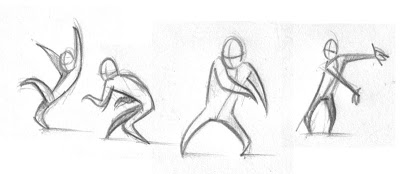On the surface, the two poses are almost identical. They have the same basic silhouette, the same centre of balance, same structure, model, anatomy, line quality... and yet, one feels loose, natural and dynamic, and the other feels almost painfully flat and awkward.
The single difference between the two poses is the twist through the body, but that one change has altered the line of action, the balance, eye direction, attitude, depth of the pose, the movement... It's changed almost every component of the pose, and taken it from a flat, awkward, static pose into a three dimensional, dynamic pose full of attitude and movement.
It's that difference that allows us to see this pose as something we can relate to and empathize with, and without that empathy, we could care less about the character.
Here's a few more poses with an obvious, dramatic twist to illustrate the point.
There is an obvious movement to poses that are this broad, and without that twist, the amount of movement, and our interest in the pose would fade. However, the twist doesn't have to be that obvious to be of any use. Here's a few more poses with a little more subtlety, but still have the depth and movement in them that a twist can provide.
Ultimately we are using this incredibly effective little trick to keep our poses looking natural and believable. If we allow our drawings to become flat and awkward, the audience begins to see them as just drawings, and not characters at all. We want people to subconsciously feel themselves in these poses, so they can believe in the character's actions and reactions. The minute we fail to convince our audience that this is a real, living breathing character, we've failed to accomplish our goal.



